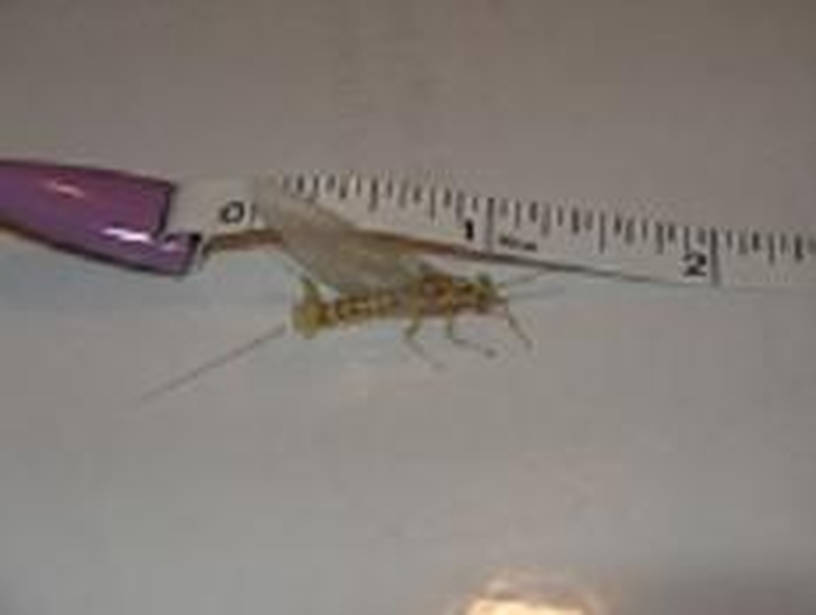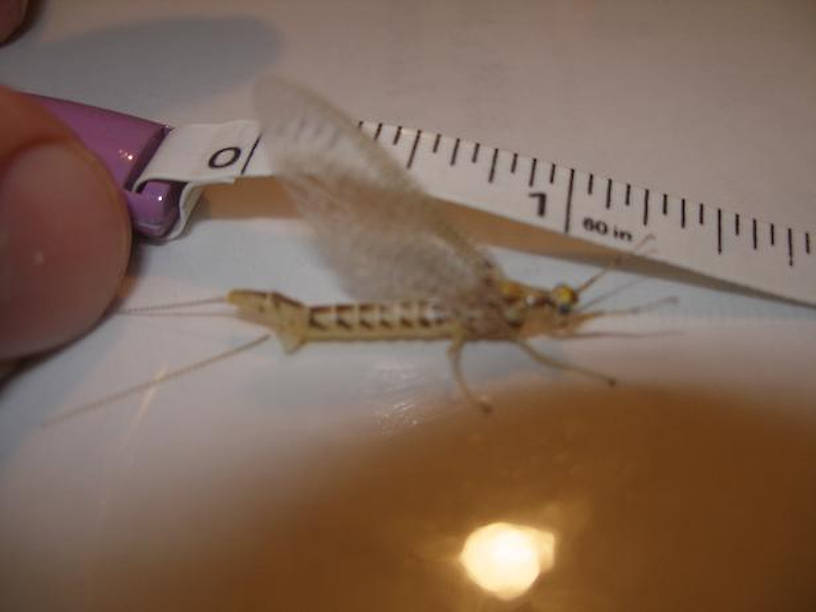Blog & Latest Updates
Fly Fishing Articles
Insects by Common Name


> > Is this a Hexagenia limbata specimen?
WovenPerla has attached these 3 pictures to aid in identification. The message is below.

The specimen was injured in transit (I had to carry it by the wings as we drove home from the ice cream stand...15min.) That's why there is an injury toward the rear of the abdomen and one of the tails had fallen off.

Here you can see that without that injury that fly is about an inch or better in length (not counting the length of the tails.)
| WovenPerla | June 18th, 2009, 8:01 pm | |
| Pennsylvania Posts: 2 | I saw two of these bugs at a local ice cream shop near the Susquehanna River just north of Harrisburg where bugs like to hang out after dark. I collected the specimen on June 18th, too late for any type of drake, so I figured it must be a Hex. I know the river and some local streams have has H. atrocaudata later on in July and in August (depending on the watershed), but I didn't know that / if there were H. limbata. Am I correct on my identification (well...assumption...I really didn't identify it in any scientific manner...just by association and elimination.) Thanks for the commentary. | |
| Taxon | June 18th, 2009, 8:50 pm | |
Site Editor Royse City, TXPosts: 1350 | Christopher- Your mayfly appears (to me) to be a Hexagenia limbata female imago. | |
| Best regards, Roger Rohrbeck www.FlyfishingEntomology.com | ||
| WovenPerla | June 19th, 2009, 7:04 am | |
| Pennsylvania Posts: 2 | Thanks. That's what I thought. I just was surprised because it seems everyone makes a big deal about them everywhere else, but no one talks about them here really. I'm assuming it hatched from the river or maybe the local trout stream nearby...do you think this would be a good fly to try and imitate with bass? Swinging wetflies? Would wet flies work after dark on the trout stream? | |
| GONZO | June 19th, 2009, 7:48 am | |
Site Editor "Bear Swamp," PAPosts: 1681 | Hi Chris, Because we recently discussed this subject, Roger is probably expecting a post from me, and I wouldn't want to disappoint him by not taking the bait. Although I agree with Roger that this does look like a Hexagenia limbata spinner, I think it could also be H. rigida. I lived in the Harrisburg area for about half of my life, and a surprising number of burrowing mayflies are found right in that immediate area. There are four Hexagenia species (limbata, rigida, atrocaudata, and bilineata) as well as Green and Yellow Drakes (Ephemera guttulata and varia). Although I haven't been able to confirm it personally, another big burrower, Litobrancha recurvata, is said to be found in at least one stream flowing into the Susquehanna in the vicinity of H-burg. (Though recurvata probably would not be found in the river.) Of the Hexagenia species, atrocaudata and bilineata can be easily ruled out. That leaves limbata and rigida. The problem is that rigida is so similar in appearance to one or two of the limbata varieties ("morphs") that they can only be conclusively identified by the distinctive genitalia of the males or the chorionic egg structures of the females. In other words, it is probably impossible to ID your specimen with any certainty based on the photo. It is my impression (and only an impression) that rigida might be the more common Hex species found in that area. Further suggestive (though not at all conclusive) evidence comes from a very nice study of Hexagenia that was done by Dr. Spieth back in the forties. In that study, he lists records of three of the four Hex (limbata, rigida, and bilineata) collected right at Harrisburg, and the fourth (atrocaudata) at Chambersburg. The interesting thing is that the Harrisburg limbata record is of the morph that was described in his study as as a subspecies of what was then considered to be a separate species, Hexagenia munda affiliata. This is now considered to be a synonym of limbata. Spieth's description of the habitat of the affiliata morph ("As yet I know it to be taken only from clear, clean, usually small streams and small lakes") would lead me to wonder if the population in the Susquehanna might be rather sparse. The dorsal markings of that morph are described as being rather different than your specimen--darker and of a different configuration--and the markings on your specimen appear to be fairly consistent with rigida. However, the catch is that such distinctions are much harder to make with female specimens of these species. So, all I can really say is that both limbata and rigida are probably found in the river, both emerge at about the same time, and your specimen could be either one. (From a fly-fishing/imitation standpoint the distinction between these species makes virtually no difference.) Although Roger could be right about this being limbata, as Dr. Spieth says in his study, "This species has always been the dispair of ephemeropterists." PS--I just noticed your latest post, Chris, and my answers would be yes, yes, and yes. I would normally imitate Hex with nymphs and dries on trout streams, but it is hard to argue against swinging a big wet after dark, even when Hex are not hatching. | |
| Taxon | June 19th, 2009, 1:20 pm | |
Site Editor Royse City, TXPosts: 1350 | In the hope of diverting some attention from another thread, and also in the interest of relieving some pressure from Gonzo, who fears he may have exceeded nearly everyone's threshold for detail in his above posting, I offer this illustration of some of Hexagenia male imago genitalia taken from the book, The Biology Of Mayflies, by Needham, Traver, and Hsu. Close examination of this illustration, and only by those whose sensibilities it does not offend, may yield appreciation for the role anatomy played in naming of certain species. | |
| Best regards, Roger Rohrbeck www.FlyfishingEntomology.com | ||
| GONZO | June 19th, 2009, 1:40 pm | |
Site Editor "Bear Swamp," PAPosts: 1681 | Nice, Roger. Thanks on both fronts. :) | |
| Wiflyfisher | June 20th, 2009, 7:29 pm | |
| Wisconsin Posts: 663 | A Hex meal.... Sorry, I did not check the male's genitalia, but I am pretty darn sure they are Hexagenia limbata duns. :) | |
| John S. https://WiFlyFisher.com | ||
| GONZO | June 21st, 2009, 11:05 am | |
Site Editor "Bear Swamp," PAPosts: 1681 | Tasty dish, John. (And you're probably safe on the ID; the only WI records of rigida that I have seen came from Dane County.) :) | |
| Shawnny3 | June 28th, 2009, 6:49 am | |
Moderator Pleasant Gap, PAPosts: 1197 | Is it the shape of the male genitalia that gives recurvata its name? -Shawn | |
| Jewelry-Quality Artistic Salmon Flies, by Shawn Davis www.davisflydesigns.com | ||
| GONZO | June 28th, 2009, 8:06 am | |
Site Editor "Bear Swamp," PAPosts: 1681 | Shawn, I believe so, and rigida is similarly descriptive. Another example of such names is the unfortunate one given to one of the Pycnopsyche caddisfly species: scabripennis. | |
| Jmd123 | June 30th, 2009, 4:42 pm | |
| Oscoda, MI Posts: 2611 | Mmmmmmmmmmmmmmmmm, yummy!! - 27" fat brownie | |
| No matter how big the one you just caught is, there's always a bigger one out there somewhere... | ||
Quick Reply
You have to be logged in to post on the forum. It's this easy:
Related Discussions
| Title | Replies | Last Reply |
| Re: Hexagenia limbata vs rigida In the Identify This! Board by Aafloyd | 4 | Nov 2, 2011 by Jmd123 |
| Re: The Hex I was talking about In the Identify This! Board by Al514 | 7 | Sep 24, 2007 by Konchu |
| Re: Hexagenia Mayflies In General Discussion by Motrout | 2 | Jun 30, 2010 by Oldredbarn |
| Re: Mahogany Dun? In the Identify This! Board by TroutNut2 | 14 | Jun 17, 2007 by GONZO |
| Re: Litobrancha in Minnesota In the Mayfly Genus Litobrancha by Dryfly | 5 | Aug 30, 2009 by GONZO |
| Re: Hex in NC??? In the Identify This! Board by CalebBoyle | 4 | May 24, 2007 by CalebBoyle |
| Re: Subimago to identify... In the Identify This! Board by Pilonm | 69 | Apr 1, 2012 by Pilonm |
| Re: Hexagenia bilineata? (2 more) In the Identify This! Board by 149113 | 6 | Jul 23, 2016 by 149113 |
| Re: This is not Ephemera simulans In Hexagenia limbata Mayfly Nymph by Beardius | 1 | Aug 2, 2008 by Troutnut |
| Re: Night Time is the Right Time In the Photography Board by Crepuscular | 8 | Sep 17, 2013 by Entoman |
Troutnut.com is copyright © 2004-2024 Jason
Neuswanger (email Jason). See my FAQ for information about use of my images.
 privacy policy
privacy policy



